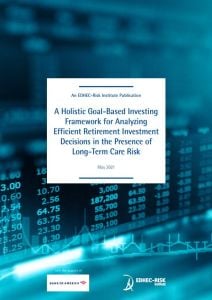

A Holistic Goal-Based Investing Framework for Analyzing Efficient Retirement Investment Decisions in the Presence of Long-Term Care Risk
One of the main goals of this paper is to assess whether the opportunity cost of such substantial rigidity may partly explain the annuity puzzle.
To perform this analysis, we introduce a ...
Author(s):
Summary:
One of the main goals of this paper is to assess whether the opportunity cost of such substantial rigidity may partly explain the annuity puzzle.
To perform this analysis, we introduce a comprehensive simulation framework that includes notably
(1) a realistic market simulation engine, incorporating Monte-Carlo simulations coupled with flexible long-term Capital Market Assumptions (CMAs), including scenarios for the whole yield curve,
(2) a realistic product simulation engine, incorporating scenarios for stocks and bonds, but also retirement goal-hedging bond portfolios, as well as a rather exhaustive range of annuity products,
(3) a realistic client simulation engine, incorporating mortality risk scenarios, as well as target levels of replacement income cash-flows, including random shocks to cash-flow due to life events such as long-term care needs, and
(4) a comprehensive goal-based investing retirement solution evaluation system, that defines and develops metrics that can be used to determine the relative value and trade-off of various options and has a focus on assessing client outcomes.
Our main findings are as follows. We first confirm that the presence of long-term care risk strongly reduces the optimal demand for annuities for most individuals. This result suggests that the costly reversibility of annuitization decisions can help explain the annuity puzzle for individuals facing life event uncertainty.
We also find that the introduction of annuity products with upside potential (e.g., variable annuities) has a positive impact on investor welfare
Register to download PDF
Register/Log in| Type : | EDHEC Publication |
|---|---|
| Date : | 28/09/2021 |

